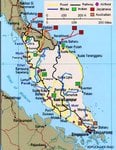Freebird
Master Sergeant
Since I've been reading about the Malaya campaign, it seems that the british may had enough troops, they were just short of aircraft and perhaps a few dozen tanks. (and competent leadership  )
)
Could they have sent enough aircraft pilots there within 6 weeks or so?
What would be the best strategy to counter the Japanese advantages in the air?
Positions on 7 dec 1941:
2 regiments of the Japanese 18th division (23rd 56th regiments) attack at the Malaysian airfield/port of Kota Baharu.
3 regiments of the Japanese 5th division land at Singora Patani, Thailand. Two columns attack down the Singora-Jitra and the Patani-Kroh roads.
7 Dec 1941 the British in Malaya have 2 Indian divisions (9th 11th), the Australian 8th division and about 2 mixed brigades in Singapore itself.
The Indian 11th division has the 6th brigade defending the road leading to Jitra, while the 15th defends the road through Kroh. the 28th brigade is in reserve at Ipoh. The Indian 9th division has the 8th brigade + a battalion of the 22nd defending Kota Baharu, while the remaining 2 battlaions of 22 brigade defend Kuantan. The Indian 12th Brigade is in army reserve.
Two brigades of the Australian 8th division (22nd 27th brigades) are defending Johore, the third is in Singapore
Questions:
1.) Aircraft: Aircraft: What aircraft could they send to Singapore within a month or so?
2.) RAF Leadership Was there an effective leader that could sort out the mess in Malaya?
Could they have sent enough aircraft pilots there within 6 weeks or so?
What would be the best strategy to counter the Japanese advantages in the air?
Positions on 7 dec 1941:
2 regiments of the Japanese 18th division (23rd 56th regiments) attack at the Malaysian airfield/port of Kota Baharu.
3 regiments of the Japanese 5th division land at Singora Patani, Thailand. Two columns attack down the Singora-Jitra and the Patani-Kroh roads.
7 Dec 1941 the British in Malaya have 2 Indian divisions (9th 11th), the Australian 8th division and about 2 mixed brigades in Singapore itself.
The Indian 11th division has the 6th brigade defending the road leading to Jitra, while the 15th defends the road through Kroh. the 28th brigade is in reserve at Ipoh. The Indian 9th division has the 8th brigade + a battalion of the 22nd defending Kota Baharu, while the remaining 2 battlaions of 22 brigade defend Kuantan. The Indian 12th Brigade is in army reserve.
Two brigades of the Australian 8th division (22nd 27th brigades) are defending Johore, the third is in Singapore
Questions:
1.) Aircraft: Aircraft: What aircraft could they send to Singapore within a month or so?
2.) RAF Leadership Was there an effective leader that could sort out the mess in Malaya?
Attachments
Last edited:

